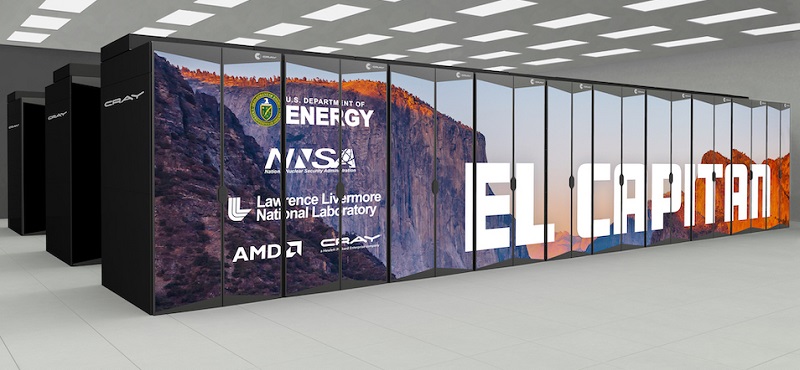As part of its 2024 budget, the White House is proposing a record $25 billion for emerging technologies as the country looks to counter the technology threat from China. The budget includes billions of dollars earmarked to boost the supercomputing infrastructure, semiconductors, and cutting-edge technologies such as artificial intelligence and quantum computing. The technology investments are in line with U.S. national interests to boost defense, scientific breakthroughs and economic forecasting.
The largest chunk of that $25 billion – $11.3 billion – is being assigned to National Science Foundation (NSF) and includes a proposal for the “construction of the Leadership-Class Computing Facility to support science and engineering research that requires the largest and most computationally intensive capabilities research infrastructure at NSF.”
The Leadership-Class Computing Facility (LCCF) has been under development at the Texas Advanced Computing Center (TACC) for some time now. In September 2022, the National Science Board authorized the NSF to include the LCCF in a future budget request – an approval that has now come to fruition. The goal is to begin construction of the LCCF in 2024 and deploy the facility in 2026. The LCCF is slated to include a roughly half-exaflop supercomputer called Horizon.
The Office of Science in the U.S. Department of Energy (DOE) is requesting $8.8 billion, which includes $35 million to create the 18th National Lab at a minority-serving institution, where it will gather scientists to do cutting edge research. Researchers at national labs are big supercomputer customers; the DOE manages a number of major supercomputing facilities in the U.S. and had four of the top ten fastest supercomputers in the world, according to the Top500 list released in November last year. That includes the world’s fastest computer (and the first public exascale system), Frontier, at Oak Ridge National Laboratory.

The next two U.S. exascale systems will also be DOE-operated: Aurora at Argonne National Laboratory and El Capitan at Lawrence Livermore National Laboratory.
The White House emerging tech budget proposal “supports cutting-edge research at the national laboratories and universities and building and operating world-class scientific user facilities and the largest investment in fusion energy in history.”
The $25 billion emerging tech budget is part of the White House’s $6.8 trillion spending plan for fiscal 2024. The emerging tech budget in 2023 was $18.5 billion.
It is unclear if the emerging tech budget includes the computing requirements of different government departments. For example, the DOE’s National Nuclear Security Administration (NNSA) has requested $23.8 billion to maintain a safe nuclear stockpile – a task for which the NNSA currently employs a wide array of powerful supercomputers.
The government has been very active on the technology front lately. The White House last week released a national cybersecurity strategy that prioritizes investments in replacing the computing infrastructure that could be vulnerable to attacks from quantum computers. As part of that, the government will transition vulnerable networks to environments that can withstand attacks from quantum computers. NIST is leading the development of quantum-resistant cryptographic algorithms.
NIST later this month is also holding a workshop to outline security strategies for high-performance computing.
The 2024 budget is not final and will only be enacted after negotiations with and revisions by the U.S. Congress, which could tweak the budget assigned to government departments. Republicans in the House of Representatives are looking to cut spending, and the 2024 budget will likely be a topic of contention with the debt ceiling deadline looming.
The U.S. government is weaponizing technology as it tightens up export controls on China and Russia, its political adversaries. Biden has banned the export of cutting-edge chips to China.
Biden made a plea to boost the R&D during his budget speech on Thursday. ”My budget is about more than chips. It is about science as well,” he said.
The U.S. had previously committed around 2% of its gross domestic product to R&D; now it is less than 1%.
“We used to rank number one in the world in research and development. You know what we rank now? Number nine,” Biden said, adding “China was number eight a decade ago. Guess what? They’re now number two.”
Biden said that the U.S. needs to support the CHIPS and Science Act passed last year with a flourishing ecosystem that supports the factories being built by companies like Intel. “America invented these chips. We made them faster, smaller, and more powerful. We used to provide 40% of them to the world. Now, today, we are down to 10%,” Biden said.
NIST is managing the CHIPS and Science Act, and finalized the application process two weeks ago. NIST is working with NSF to build out the technology infrastructure.
The CHIPS and Science Act opens more than $50 billion in incentives to boost semiconductor manufacturing, research, and workforce development. Chipmakers are slotted to receive $39 billion in incentives to open new and legacy factories. The rest will go into the establishment of the National Semiconductor Technology Center and “manufacturing institutes” that could serve as incubators for technology R&D done by the likes of the U.S. Department of Defense. The DOD includes both DARPA and IARPA, which is creating a new computing architecture to cut the energy requirements of a high-performance computer.
The White House budget proposal can be accessed at this link.




























































